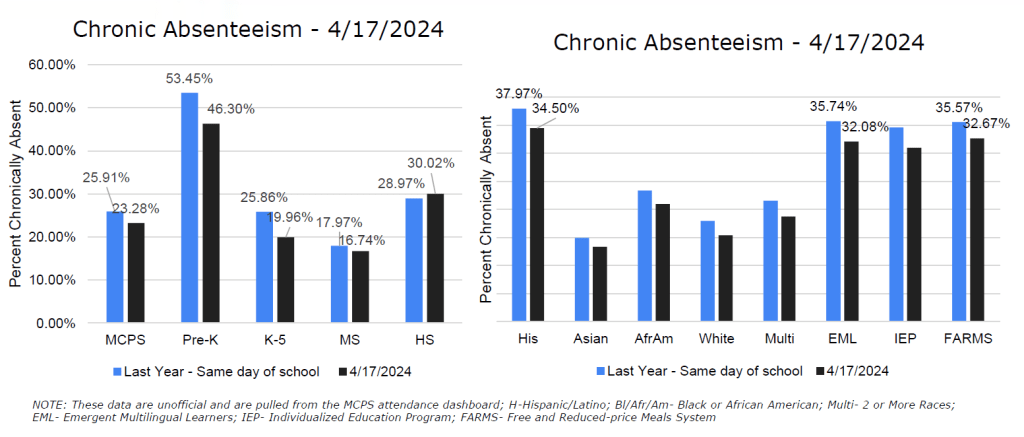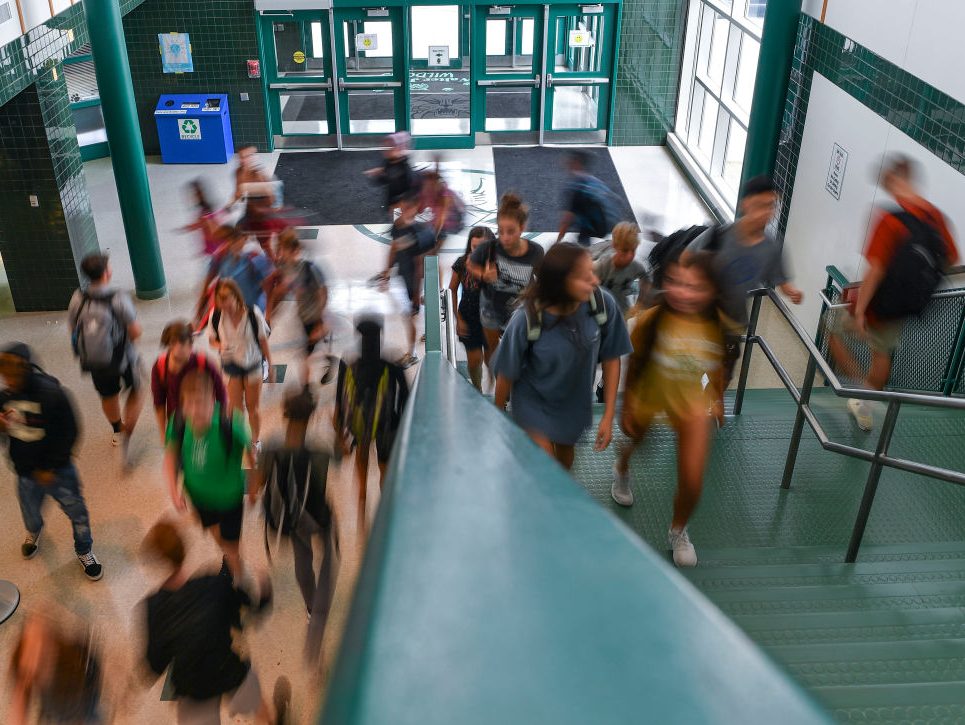This story, originally published at 11:31 a.m. June 21, was updated at 8:38 a.m. June 26, 2024, to remove an incorrect reference to the absenteeism rate of Baltimore County public schools.
Efforts to decrease chronic absenteeism among Montgomery County Public Schools students are showing modest success, mostly among younger students but less so among high schoolers, district data shows.
Following the COVID-19 pandemic, MCPS—like other school districts nationwide–saw a sharp rise in the number of chronically absent students across all grade levels. During the 2022-2023 school year–the first year back to full in-person instruction after the pandemic–more than one in four (26%) MCPS students were chronically absent, according to MCPS data.
In August 2023, the district launched an attendance action plan to reduce the number of students who were chronically missing school, according to MCPS officials. As a result, MCPS saw a decline in chronic absenteeism rates during the 2023-2024 school year, with about 23.2% of students chronically absent, according to the data.
MCPS defines chronic absence as missing 18 or more days in a school year, or 10% of the academic calendar, regardless of the reason, according to Steve Neff, director of Pupil Personnel and Attendance Services at MCPS.
That is “basically two days a month, so it’s not too hard to get there relatively quickly,” Neff told MoCo360 this month.
According to district data, chronic absenteeism rates for elementary school students decreased from 24.3% in the 2022-2023 school year to 18.5% in the 2023-2024 school year.
For middle school students, the rate decreased slightly from 17.9% in the 2022-2023 school year to about 16.5% in the 2023-2024 school year, according to MCPS data.
While the slight dip in the chronic absenteeism rate indicates that MCPS is making progress, not all efforts have been successful. The district struggled to make improvements with high school students in particular, according to MCPS data.
In the 2022-2023 school year, the chronic absenteeism rate for high school students was 31.4%. In the 2023-2024 school year, the rate increased slightly to 32%, according to district data.
Data from the Maryland State Department of Education shows that in the 2022-2023 school year, Walt Whitman High School in Bethesda had the lowest chronic absenteeism rate, at 15.1%, among all district high schools. In contrast, Watkins Mill High School in Gaithersburg had the highest level of chronic absenteeism in the district, with 50.4% of students chronically absent. Data for the 2023-2024 school year is not yet available.
“We’ve seen the gains as a system and as you dig deeper into those gains, there are a lot at the elementary level, modest at the middle school level, and we’re basically treading water … at the high school level,” Neff said.
The district’s overall chronic absenteeism rate was lower than the state’s average of 29.8% in the 2022-2023 school year, according to state education department data.
MCPS, the largest school system in the state with an enrollment of more than 160,000 students, also fares better in comparison to the other larger school districts in Maryland. In Prince George’s County, for example, the school system serving more than 131,000 students–the second largest district in the state–saw a decline in its chronic absenteeism from about 35% in January 2023 to 29% in January 2024.
Even before the pandemic, chronic absenteeism rates in MCPS were “creeping up,” according to Neff. But once the pandemic hit, “all bets were off,” he says.
Neff noted that attendance rates “got very wonky” during the pandemic when students were learning virtually and afterward when students returned to in-person instruction.
He attributes the absenteeism from the start of the pandemic to the 2022-2023 school year to a combination of the occurrence of COVID variants, messaging from schools to keep sick children from attending school in person, relaxed attendance and grading policies, and families worried about sending their child to school once in-person classes resumed.
Before the COVID-19 pandemic, in the 2018-2019 school year, about 19.6% of all MCPS students districtwide were chronically absent, according to an MCPS press release. After the pandemic, Neff said officials in MCPS and districts across the nation expected to see chronic absenteeism in their school systems decline. Instead, absenteeism rates continued to climb.
Launching an action plan
In response, MCPS launched an attendance action plan at the start of the 2023-2024 school year called “ALL TOGETHER NOW: In School Together, Learning Together, Achieving Together,” which aimed to take a less punitive approach to getting students back to regularly attending school, according to Neff.
“We’ve spent the year trying to message the importance of regular school attendance, providing schools with access to real-time data instead of lagging data, having positive outreach to families and doing root cause analysis and targeted interventions,” Neff said.
He noted that the district has been “throwing everything we possibly could” at its chronic absenteeism issue because officials realized knew there wasn’t just one strategy that would provide an immediate fix. “It is a multi-prong and a multi-year approach,” he said.
Research also indicates that there are multiple reasons why students may be chronically absent. Children living in poverty are more likely to be chronically absent and students from communities of color and with disabilities are also disproportionately affected, according to Attendance Works, a California-based nonprofit organization that aims to help improve student chronic absence across the United States.
MCPS partnered with the nonprofit during the 2023-2024 school year to support a handful of schools, such as Bel Pre Elementary School in Silver Spring, in improving student attendance and parent engagement on the issue.
According to MCPS data, more than 78% of students at Bel Pre Elementary received Free and Reduced Price Meals (FARMs) services. In the 2022-2023 school year, 58% of the school population was Hispanic/Latino, 27.4% were Black or African American and 6.1% of students were white.
Bel Pre Elementary is also a designated federal Title I school. Title I funding is provided to schools with high numbers of children from low-income families and is used to support “social-emotional learning, extra instruction in reading and mathematics, additional teachers, materials of instruction, as well as after-school and summer programs,” according to the state education department.
Catherine Cooney, communications director for Attendance Works, noted in an email to MoCo360 that there are multiple reasons why students are chronically absent, and the reasons can vary depending on the student population.
“We think some issues are affecting all students–kids are struggling with feeling engaged and connected to school (this is why relationships matter so much), students report more anxiety and depression than ever before, families may think that showing up to school isn’t as essential and believe they can make things up electronically,” Cooney wrote.
“Families in low-income communities may especially be struggling with lack of access to health care, housing, food insecurity, unreliable health care,” she said. “And, more families of all types might have lost out on access to health care [and] following the pandemic, may now feel confused about when to send their child to school when they have a minor symptom of illness.”
Over the past year, one of the attendance strategies that worked well was “flooding the airwaves” and communicating often through emails and school messages about the importance of attendance, especially to newcomer families and families of younger students, Neff said.
Much of the communication with those families was related to dispelling the myths about when it’s OK to miss school and when it is not–such as when there is bad weather, on half days and the days before and after major holidays, according to Neff.
Success at Bel Pre Elementary
At a May 9 school board meeting, district officials discussed progress in lowering chronic absenteeism rates and highlighted the work being done at Bel Pre Elementary in a short video. At the school, teachers and staff worked under the guidance of Attendance Works to collaborate with parents to improve the attendance of chronically absent students.
Bel Pre Elementary parent Jacqueline Jarret said in the video the school helped her understand the importance of sending her son to class every day. She was also able to meet with the school’s social worker and principal who provided resources for child care.
Jarret said that obtaining child care was one of the obstacles she faced in getting her son on the school bus in the morning every day.
Another parent in the video, Virginia Vasquez, said she also received similar support from the school. “When I couldn’t send my son to school, they approached me and asked me, ‘How can we help you?’,” Vasquez said in Spanish. “They gave me ideas and options to be able to improve that with my son.”
Bel Pre Elementary also implemented a student mentorship program called Panda Pals, alluding to the school’s panda mascot, to address chronic absenteeism. According to the video, the program pairs students who are in the 15% to 19% chronically absent range with a staff mentor in the school. This mentor meets with the student every school day, recognizes the student for attending school and builds a relationship with the student, according to the video.
“We have consistently seen a steady decline in the chronic absenteeism rates of our students, so we’re very proud of that,” Bel Pre Principal Dara Brooks said in the video.
Brooks said the school also started “listen and learn” meetings with families and school staff “to introduce and start to have face-to-face conversations with them [about] how school works, how school is here to support their child through any barriers that they feel they need support.”
Accessing real-time data
Another aspect of the district’s attendance action plan that Neff believed worked well was the ability to access to real-time attendance data for the first time. According to Neff, in March the district’s technology department created a dashboard that allows schools to look at current data and compare it to figures from the previous school year.
Neff said schools can use the dashboard to drill down into the demographics of grade-level data of those students missing school, such as looking at racial and ethnic groups, and students receiving special education and English language development services as well as FARMs services.

“Before [the dashboard] became available, [schools] would be comparing [attendance data] to where it ended last year. And they would always say, ‘Well, how does that compare to where we were this time last year?’ ” Neff said. “Until probably early March, we couldn’t accurately answer that. Now we can.”
District officials have some ideas as to why the district’s messaging and outreach this past school year hasn’t worked with high schoolers. One possible reason why high school students miss school is they have responsibilities such as jobs to support their families and caring for younger siblings, Neff said.
Other reasons district officials have identified are the grading and reporting practices in high schools post-pandemic. Neff acknowledged that components of MCPS policies and practices in high schools “disincentivize students” from attending class, especially if work can be done virtually.
Neff said he believes there were areas where MCPS could “tighten up” their grading and attendance policies but didn’t specify what changes could be made.
“But what we know is we know we don’t want them to be punitive. And we know we want grades to reflect what students know and are able to do,” he said.
Sami Saeed, the student member of the county school board, has been critical of the school system’s attendance and grading policies. He told MoCo360 in May it was “disheartening” to see the increase in chronic absenteeism at the high school level.
“With chronic absenteeism, students just know that when there are no consequences for skipping or not coming to school or leaving early, a lot of students are going to simply do it because nothing happens if they do. There aren’t repercussions,” he said.
Saeed acknowledged that a stricter attendance policy for unexcused absences that could lead to detentions or loss of credit or an inability to make up missed work wouldn’t be popular among students. However, he believes it is important for students to hold themselves accountable for their attendance.
“If you don’t have repercussions for behavior and actions that aren’t good, I mean, people are going to exploit them. And that’s just the way things are,” he said.
Looking ahead to the next school year, Neff said MCPS officials expect to continue working on their approach to informing parents about the number of school days their student has missed and focus on making improvements at the high school level.
The district would likely aim to decrease the chronic absenteeism rate by as much as three percentage points, according to Neff. But that decline will take the effort of the entire MCPS community, not just district officials, he said.
“We can’t do it without … parents,” Neff said. “There’s nothing we can or want to do that will make you send your child to school or come to school. We want you to want to send your child or come to school because how you feel and what you experience while you’re inside our buildings is positive. It’s a place you want to be.”





